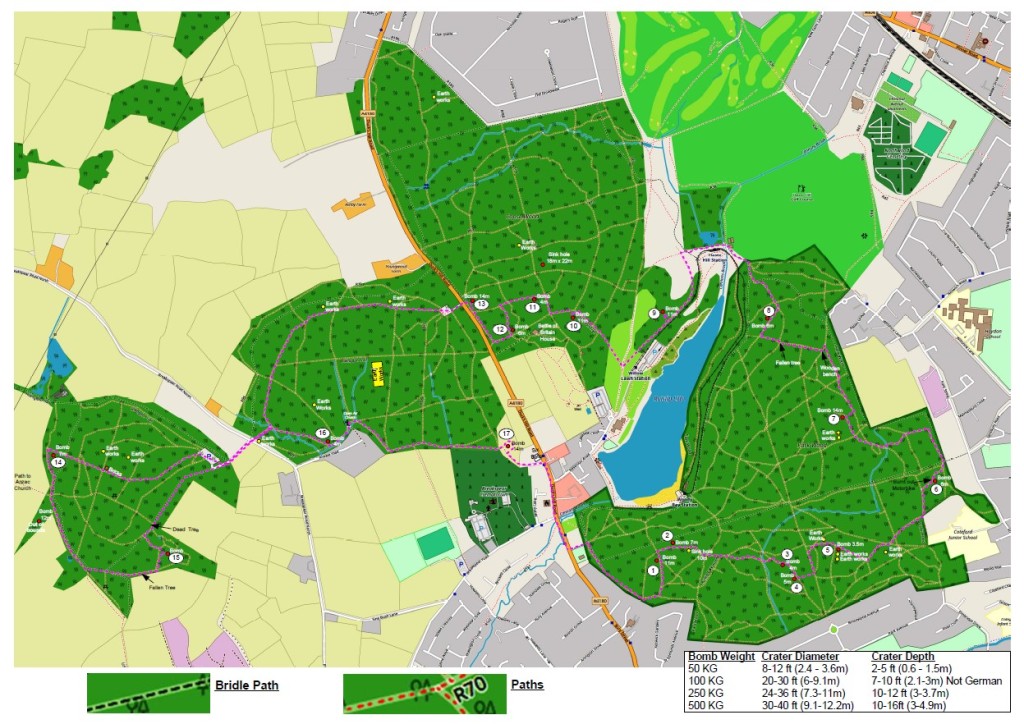An astonishing 579 bombs hit Hillingdon during the Blitz. Hunting for those craters is a fantastic way to experience the area.
Some of you may know Bombsight , a great website mapping out the locations where bombs, incendiary devices, doodlebugs and other airborne implements of war dropped from the skies over London, courtesy of the Luftwaffe. In recent years, I found myself using it a fair bit, locating the craters left behind, and thinking about the ways Blitz marked London’s soil, as well as the lives of Londoners.
In the built up areas of central London such craters have since been filled in, the visible marks of war smoothing as time went by. In Hillingdon, however, blessed with fabulous rolling countryside and woodland, the marks of war are still visible. All it takes is getting up and getting out, armed with a map, good shoes, and some patience.
Hunting for craters is a great excuse to get out of the couch and into the streets and woods of the neighbourhood. For me, it justifies my strolls – I just can’t stand walking around aimlessly just to take in the fresh air. I need goals. So chasing after old WW2 craters and other historic landmarks is my way to keep fit and healthy, know my neighbourhood better, and satisfy my need for experiencing history !
Recently, I was made aware of a very special piece of kit : it is a detailed map of all bomb crater locations in Ruislip Woods. This is actually much more than dots on a map There is a expansive legend featuring numbered locations, paths, landmarks, even crater diameters to bomb types – an excellent and informative companion for your next walk!

The high quality map was created on behalf of the Hillingdon Athletic Club as an orienteering checklist. I am making it available for download here courtesy of its creator, Mr Nigel Ealand – with special thanks to Mrs Suzy Nowlan for bringing this to my attention. Download it as a .pdf using the link below :
Mr Ealand further explains : “If you have wondered why some of the craters are quite small the answer is the Germans never had a heavy bomber. The Dornier Do-17 was a two engine bomber and nicknamed the “Flying Pencil”. It could carry a payload of 1000Kg. It had four bomber racks and was configured to carry either two 500Kg or four 250Kg bombs, but the weight limited its range. The alternative was to carry half the payload of ten 50Kg bombs. There is only one Do-17 left in existence and it was recovered from the Goodwin Sands on the 10 June 2013 and is now exhibited at RAF Cosford . I had the pleasure of organising the BBC News coverage of the raising.”
Here’s the new coverage about The Last Dornier 17 :
I hope you’ll enjoy many interesting walks in Ruislip Woods using this excellent map! Send in your pictures of any bomb craters you spot, and I’ll be delighted to add you to a new Ruislip Bomb Crater Gallery I’ll be putting together in the next few weeks.


Hi there,
This is an excellent map and I hope it stays on the internet permanently as it is a useful resource for visitors to Ruislip Woods. Many thanks to the athletics club for arranging to get it produced. The directions to the bomb craters are good but could I ask whether you have ever thought of using the What Three Words app for defining the positions of the craters as a lot of people have this app. Also, I would be interested to know how you distinguished sink holes from bomb craters? I think that there are also some telephone wire holders still attached to some trees in Park Wood which might date from WW2 so I will do a bit more research about these in case they could be mentioned in your commentary. I look forward to visiting some of the craters. I don’t have a web site so I have put the Battle of Britain House address in so that I can send this message.
Thanks,
John Scrivens
LikeLike
Hi John. Thank you for your kind message.The map is fantastic. These are some great suggestions, I am wondering if you would like to send these directly to Hillingdon Athletic Club for the attention of Mr Nigel Ealand, the creator of the map.
I am curious to hear about what you might find out about the telephone wire holders. I haven’t noticed any on trees, but there are certainly a number of cut-down telephone poles around. I will be very happy to host your photos as well as anything relevant you may discover on this site.
take care.
Evan Panagopoulos
LikeLike